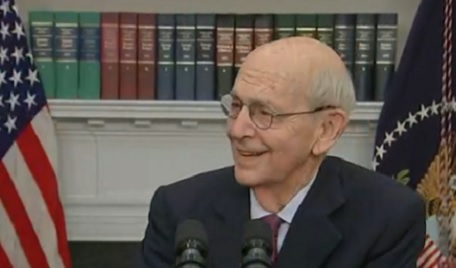Editor's Note: On February 25, 2020, the White House released a statement that Ketanji Brown Jackson, a judge on U.S. Court of Appeals for the D.C. Circuit, would be nomimated by President Joseph Biden, to replace Justice Stephen Breyer on the court.
With the official announcement of Justice Stephen Breyer’s retirement from the Supreme Court after its current term, all attention will turn to the nomination of Breyer’s successor.
 In a letter to President Joseph Biden, Justice Breyer said he will remain on the bench until the Court concludes arguments and decisions in late June or early July 2022. President Biden has said he will announce his replacement for Justice Breyer in late February.
In a letter to President Joseph Biden, Justice Breyer said he will remain on the bench until the Court concludes arguments and decisions in late June or early July 2022. President Biden has said he will announce his replacement for Justice Breyer in late February.
Under the Constitution’s Appointments Clause in Article II, Section 2, Clause 2, the President “shall nominate, and by and with the Advice and Consent of the Senate, shall appoint … Judges of the supreme Court.” The Supreme Court nomination process therefore starts with that announcement by the president. The president then will officially notify the Senate of the nomination—usually via a written statement.
Article I Section 5 of the Constitution allows both houses of Congress to create their own rules for proceedings, including the judicial confirmation process. And under the Senate’s current standing rules, the nomination is sent to the Senate Judiciary Committee, unless the nominee is a current or former Senate member.
In recent years, the average Supreme Court nomination and confirmation process has taken between two and three months. The nomination and confirmation process for Justice Brett Kavanaugh lasted a little under three months, while the same process for Justice Neil Gorsuch took a little over two months. The process for Justice Amy Coney Barrett took 27 days, with Barrett’s confirmation occurring about a week before the 2020 general election.
In the case of Breyer’s replacement, it is not clear how long the nomination and process will last. Senate Judiciary chair Richard Durbin has said the process will be handled “expeditiously.” Once the president’s nomination is sent to the Senate, the Senator Durbin will authorize a pre-hearing investigative stage about the nominee, followed by public hearings at the Judiciary Committee and a decision on a recommendation to the full Senate.
Traditionally, the nominee first undergoes an extensive investigation process and meets with senators who are part of the approval process. Next, the nominee usually appears at a public hearing at the Senate, facing a variety of questions from the Judiciary Committee. By a majority vote, the Judiciary Committee can report the nomination favorably, report it unfavorably, or report it without making any recommendation at all. It is also possible for the committee to take no action of any type to send a report to the full Senate.
Once a recommendation vote is taken by the Judiciary Committee, and the nomination is sent to the entire Senate for a floor vote, a simple majority is needed to confirm the nominee–so at least 50 votes are needed to confirm the nominee if the full Senate is present and voting. The filibuster for Supreme Court nominees was eliminated in 2017, which would have required 60 votes for the nomination to receive a floor vote under cloture rules.
When the nomination is reported to the full Senate for consideration, it is placed on its Executive Calendar. The Senate Majority Leader, Chuck Schumer, decides how to approach the voting process. In 2020, then-Senate Majority Leader Mitch McConnell concluded the floor debate over Barrett’s confirmation after just three days.
The Democrats (including Independents) and Republicans each have 50 seats in the current Senate, and if the votes on the nominee were evenly split, Vice President Kamala Harris would vote to break a tie, bringing the vote count to 51.
Some political observers expect the Senate Democratic leadership to act quickly on President Biden’s nomination, given the slim Democratic advantage in the current Senate. If Biden’s nominee is confirmed, the next question would be the timing of Breyer’s retirement and the new Justice’s appointment to the bench.
According to the Congressional Research Service, after a successful confirmation vote “the Secretary of the Senate then attests to a resolution of confirmation and transmits it to the White House. In turn, the president signs a document, called a commission, officially appointing the individual to the Court.” The date stated on the commission document is the first day the appointee is eligible to take two oaths of office under the Constitution.
The CRS said that under the Judiciary Act of 1789 the Supreme Court considers “the date a Justice takes the judicial oath as the beginning of his or her service.” The second oath is a constitutional oath required by Article VI.
So the successful nominee could be a Justice-in-waiting for some time if the confirmation process is concluded on the same timetable as Justice Barrett’s confirmation in October 2020.
Scott Bomboy is editor in chief of the National Constitution Center.







